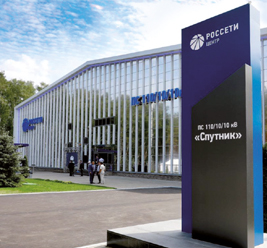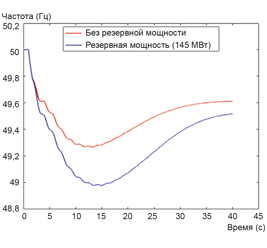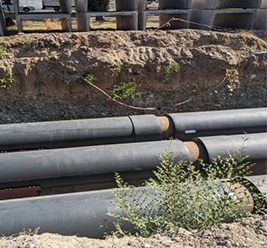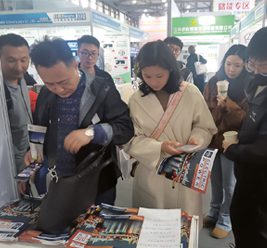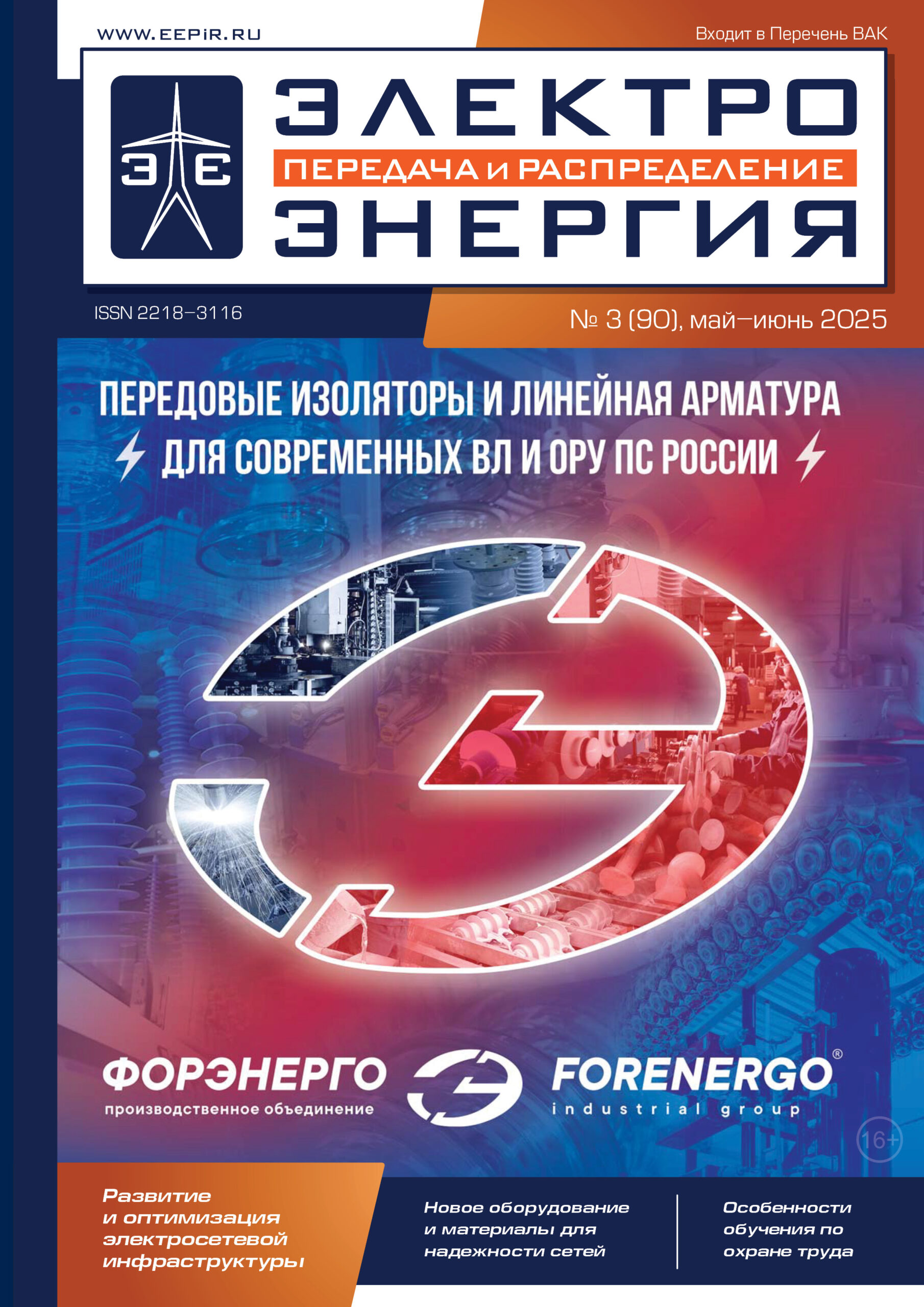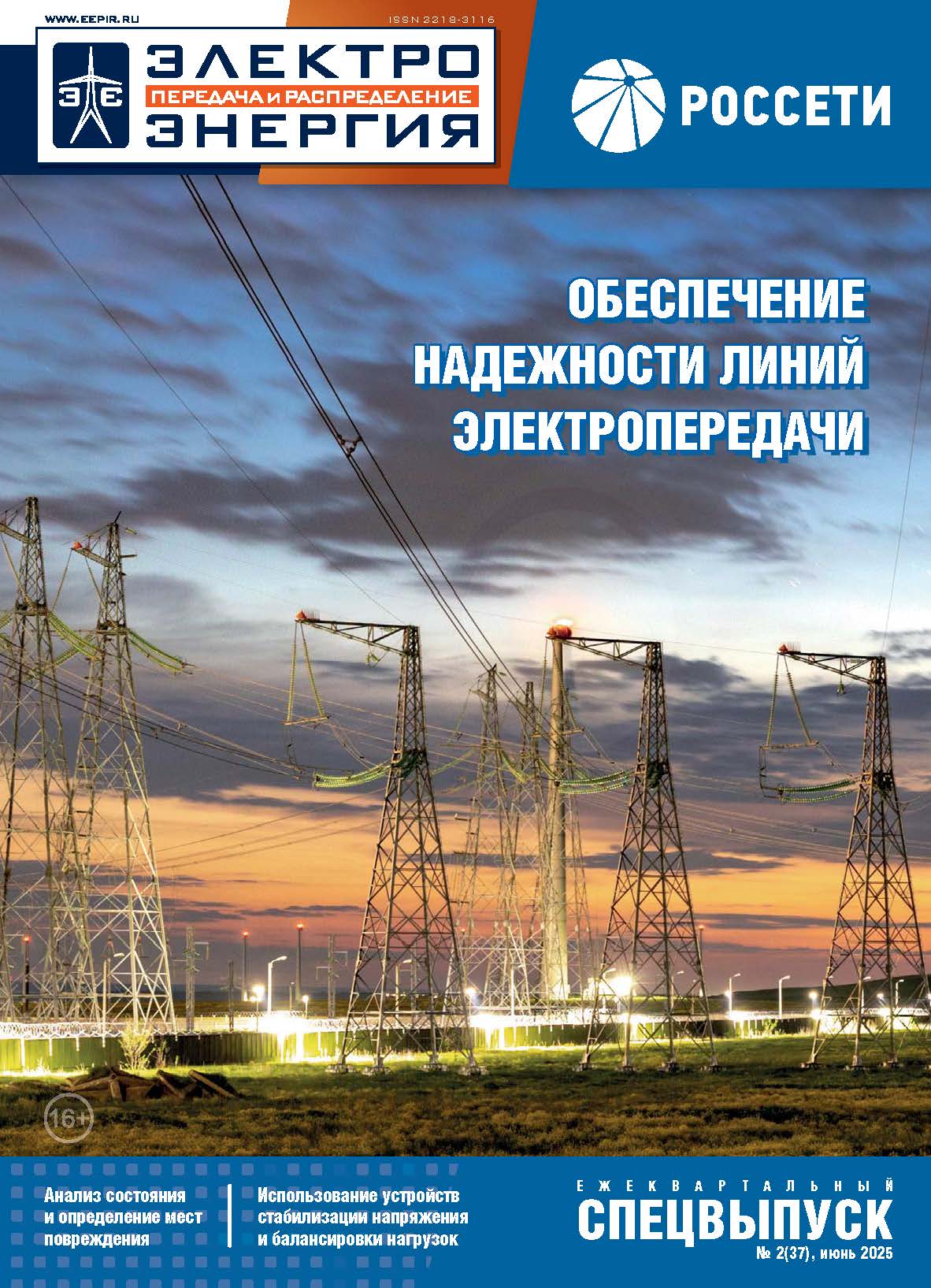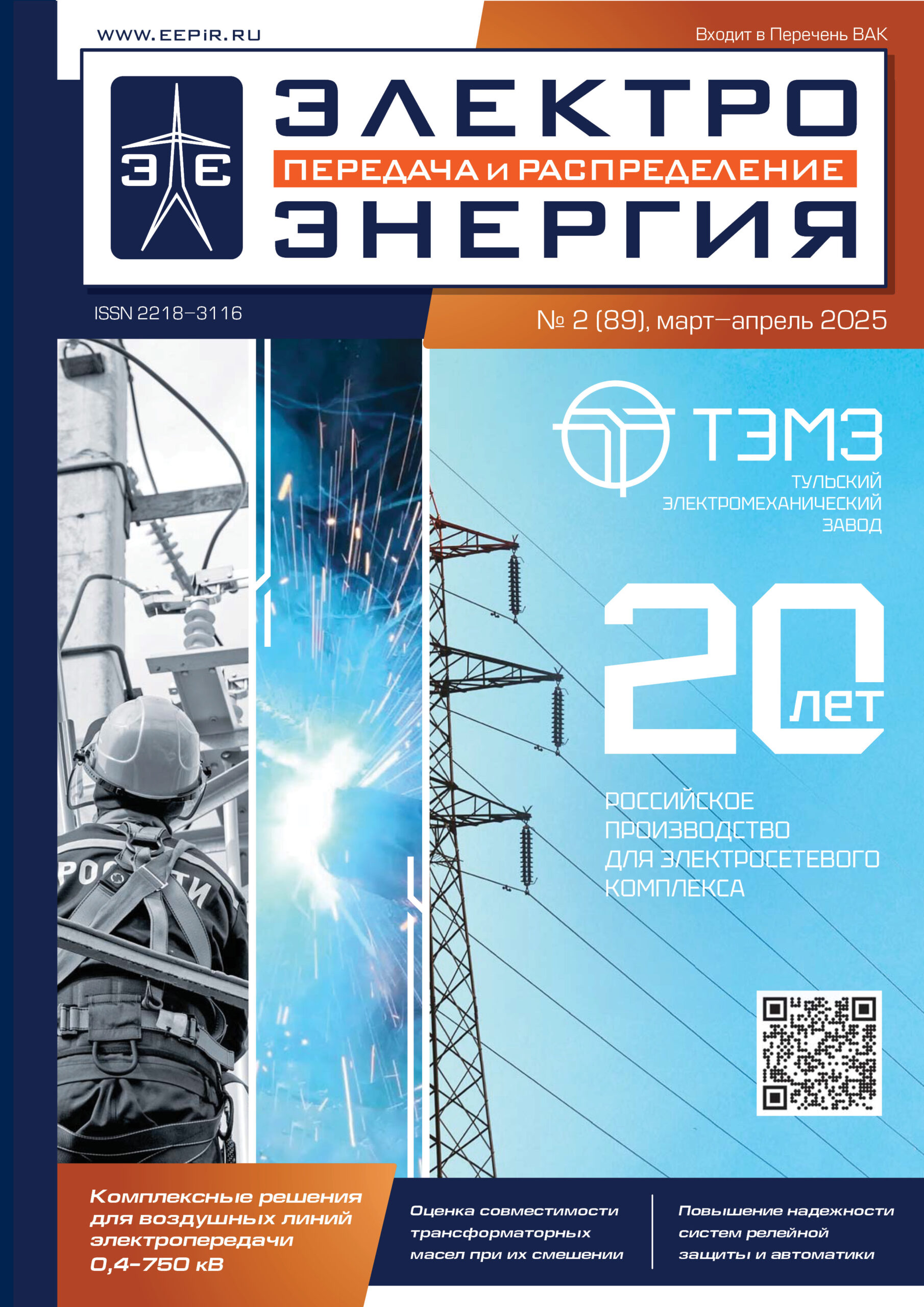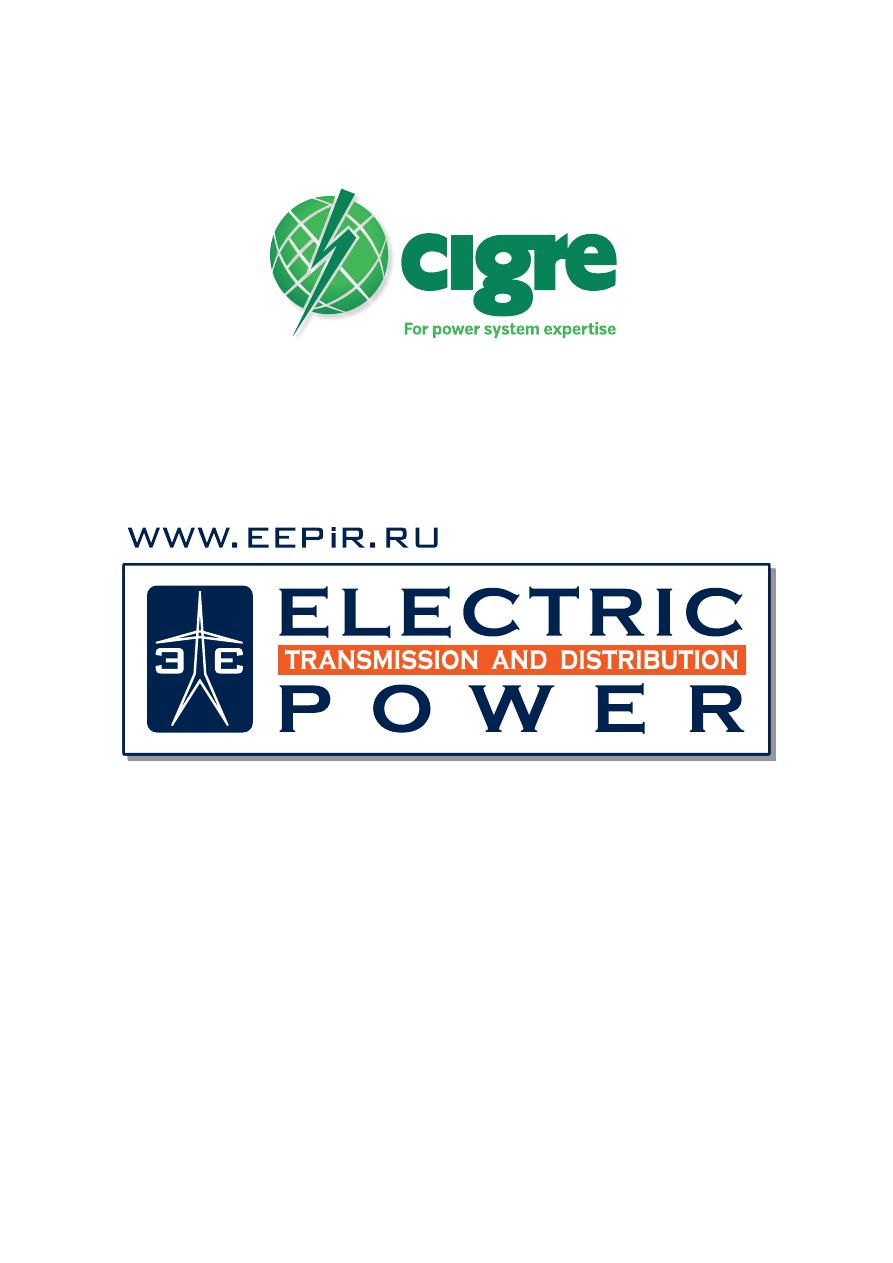
The MAIN JOURNAL for POWER GRID SPECIALISTS in RUSSIA

24
Digital Networks Construction
in ROSSETI Group
Today power engineering development is largely determined by technological break-
throughs, taking place in various economy sectors. Within this framework, electric
power industry task is not only to keep up with constant technology changes and
power consumers requirements, but also to be one step ahead, as global energy
changes with technological paradigm shift is instantly impossible [1].
F
rom a technological view-
point, the main develop-
ment will be directed to-
wards the automation
and control systems in the next
20-30 years. It is impossible with-
out increasing electric networks ob-
servability and manageability.
Electric power engineering
should be improved and be on
par with information technology in
the digital economy. Electric net-
works of the future are digital net-
works [1].
According to ROSSETI Group
de
fi
nition, "Digital network is a set
of electric grid facilities where ef-
fective management key factor is
digital data. The usage of high-
volume data processing and results
analysis allows electric grid com-
panies to improve signi
fi
cantly the
ef
fi
ciency, availability and service
quality for consumers".
Generation, transmission and
processing of data on electric grid
conditions and electric network
modes in digital form can be depict-
ed in the pyramid form (Figure 1).
The basic level of digitalization
is the primary sensors, directly
reading and transmitting informa-
tion about digital network param-
eters. For 0.4 kV electrical network,
those primary sensors are digital
energy meters (modern smart me-
ters). Currently, digital meters can
perform not only direct functions of
measuring amount of electric pow-
er, but also record various electrical
characteristics required for intelli-
gent digital control of the network.
In addition, the joint use of digital
meters and modern protective de-
vices gives the greatest economic
effect associated with accounting
and minimization of losses and
consumers load managing.
Digitalization of 6 kV and above
electrical networks is achieved
by ensuring observability and
controll ability of facilities and relay
protection and automation devices
with innovative algorithms imple-
mentation. As known, a number
of distribution network substations
are operated without telesignali-
zation and telecontrol at the mo-
Figure 1. Digital network structure
Digital network management systems
Smart metering
Teleautomation
Connection/Cybersecurity
Managed network elements
Digital
data
mana-
gement
Digital
data
gene-
ration
DIGIT
AL
NETWORK
Dmitriy
GVOZDEV,
Chief Engineer,
PJSC ROSSETI
Vladimir
UKOLOV,
Deputy Director of the
Situation and Analytical
Center, PJSC ROSSETI
Dmitriy
KHIZHKIN,
Deputy Head of the
Information Security
Department,
PJSC ROSSETI
Evgeniy
SELEZENEV,
Deputy Head of the
Technical Department,
PJSC ROSSETI
Aleksandr
KARTUSHIN,
Chief Expert,
Technical Solutions
Division, Operational
and Technological
Management Department,
PJSC ROSSETI
Valeriy
KIRILENKOV,
Chief Expert, Division
of Relay Protection
and Automation
Development, Operational
and Technological
Management Department,
PJSC ROSSETI
power grids digit
aliz
a
tion

25
ment. Therefore, such substations
can’t operatively react on changes
of network operating modes. Te-
lemetry and telecommand of dis-
tribution network substations will
ensure controllability within the
shortest possible time and with
minimal reconstruction of the main
equipment. According to ROSSETI
Group viewpoint, the global re-
placement of outdated switching
devices is not required. The main
equipment will be replaced on
a scheduled basis. Renovation will
be coordinated with facility digitali-
zation plans. It is necessary to pro-
vide transmitting and processing
of switching devices status data
in the digital network by means of
telecontrol devices. Switching con-
trol should ensure normal mode
of electrical network. Also, digital
network should provide automatic
remote control instead of mechani-
cal actions conducted by network
operator and substation electri-
cian.
The third digitalization level is
the provision of all power grid facili-
ties and operational staff with reli-
able and safe digital communica-
tions. In addition, this digitalization
level is meant to ensure continuous
and integrated security of informa-
tion systems, telecommunications
networks, software and soft hard-
ware designed for technological
and production equipment monitor-
ing and management.
With the advent of the fourth in-
dustrial revolution, isolation of the
technological network from any
external systems can no longer be
considered as an adequate protec-
tive measure. Digital network re-
quires the interfacing of corporate
and technological automated con-
trol systems and greater freedom
of communication. As a result, the
technological network becomes
more and more similar to the corpo-
rate one. They have the same use
scenario and techniques in ope-
ration. Therefore, the threats to in-
dustrial automated control systems
are similar to the threats of corpo-
rate systems.
At the same time, there is an-
other world trend: the growth of
detectable vulnerabilities in the
software of industrial automation
systems. Computer attacks on in-
dustrial facilities become more so-
phisticated and dangerous.
For ensuring continuous and in-
tegrated security of information in-
frastructure, ROSSETI Group plans
to implement a security strategy
based on automating the detec-
tion and prevention of computer at-
tacks. It is planned to use machine
learning algorithms and heuristic
analysis, as well as technologies
of the fastest possible recovery of
information infrastructure.
Energy entities in ROSSETI
Group have a task to create a se-
curity system for information infra-
structure facilities. The system will
represent typical territorially distrib-
uted complex designed to detect
and prevent computer attacks and
eliminating the consequences of
computer incidents.
ROSSETI Group uses such mo-
dern switching devices as automat-
ic reclosers, circuit breakers and
disconnecting devices with motor
drive to ensure the required level
of power supply reliability, to lo-
cate damaged areas and to restore
post-emergency network scheme.
It should be noted that digital me-
ters with embedded switching de-
vices can be applied as control-
lable elements for 0.4 kV electrical
networks.
The top of digital network is an
automated control system includ-
ing display facilities of network ele-
ments and network management.
The automated system is used for
production assets management
and repair of power grid facilities
based on information on their tech-
nical condition.
Currently, ROSSETI Group has
implemented a software package
providing the possibility of tran-
sition to a risk-based model of
production assets management
(PAM). The task of the software
is to optimize production program
costs while improving equipment
reliability (Figure 2).
The task is executed using
risk-based asset management
methodo logy including techniques
for assessing main equipment
technical condition, failure probabi-
lity and
fi
nancial consequences
of equipment failure. Important
components of the production as-
sets management system are re-
mote monitoring and diag
nostic
subsystems using BigData tech-
nologies with predictive analy
tics
functions.
PAM application scenario is
implemented for risk-oriented ma-
nagement of information infrastruc-
ture facilities taking into account
facility life cycle, technical main-
tenance organization and critical
software updates installation.
Depending on power grid equip-
ment (Table 1), a different amount of
digital technologies is required. For
the purposes of effective decision-
making on equipment replacement
ROSSETI Group has developed
a matrix of technical solutions, con-
taining the rules for replacement
of various equipment with modern
digital analogs (Table 2).
The implementation of large-
scale power grid equipment up-
dating is planned for several years
and therefore should be conducted
step by step. It will gradually de-
velop hardware architecture, soft-
Figure 2. Existing and targeted relations between costs and reliability
High reliability
when low costs
COSTS
RELIABILITY
INDEXES
High reliability
when high costs
47th CIGRE Session
Special issue, August 2018

26
ware and information support. In
addition, large-scale plans require
signi
fi
cant
fi
nancial costs. It is obvi-
ous, that continuous replacement of
all devices with digital ones will not
provide the necessary economic
effect. By this reasoning ROSSETI
Group has implemented differenti-
ated approach to power grid facili-
ties digitalization:
• The reconstruction is required
for 35 kV and above substations
aged 50 years or more;
• The equipment upgrading is
required for facilities aged
20-50 years old. Before upgrad-
ing it is rational to increase
observability of the facilities
through ensuring remote sig-
naling of switching devices and
telemetry on outgoing feeders;
• For relatively "young" substa-
tions aged 10-20 years, it is
possible to achieve a higher
level of digitalization by orga-
nizing digital return transmission
of remote measurement signals
from the Network Management
Center (signals transmission
can be ful
fi
lled by system opera-
tor or special-purpose software
package);
• The substations aged up to
10 years already have elements
of digital technologies. Automat-
ed control system organization
is the only task to accomplish
there;
• The substations under construc-
tion should be designed with the
use of modern power and sec-
ondary equipment and digital
data exchange based on IEC
61850 protocols.
Within the framework of the digi-
tal network implementation project,
four main digital technologies are
studied by ROSSETI Group:
1.
Network Management Center
(NMC).
Within the framework of
this direction, technologies de-
velopment for building a single
information system of operation-
al, technological and situational
management is under way. The
system should ensure network
model design, automated ope-
rational data collection at all
management levels and well-
founded and well-timed ma-
nagement decisions.
2.
Digital electrician.
Within the
framework of this direction, the
automated control over opera-
tional and repair personnel ac-
tions and the transformation
of document circulation into
digital form are introduced (us-
ing mobile digital devices). By
2030 it is planned to provide
each electrician with means of
augmented reality (all neces-
sary information for decision-
making will be displayed on the
protective shield of electrician's
helmet).
3.
Digital power distribution zone
(PDZ).
Within the framework of
this direction, basic commercial
technologies prototypes of the
target network business model
are tested through integrated
pilot projects. Also, economic
model is veri
fi
ed. All results are
used for subsequent replica-
tion. All these developments
are implemented in practice.
First results of electric networks
digitalization have shown that
ROSSETI Group is on the right
track.
For example, digital tech-
nologies implementation in the
Kaliningrad region (JSC "Yan-
tarenergo") in 2016 showed the
following positive effects:
– outages frequency and aver-
age power supply recovery
time were decreased;
– undersupply of energy was
reduced;
– power losses were reduced,
hence electricity payments
for ordinary consumers were
decreased.
4.
Digital substation.
Within the
framework of this direction, the
following works are carried out:
– determination of optimal di-
gital substation structure (in-
cluding individual systems of
the substation);
– statistics collection on equip-
ment reliability;
– personnel training, creation
of competence centers;
– international standards re-
view and domestic regulatory
documentation development.
For determining optimal digi-
tal substation structure, ROSSETI
Group have developed three types
of architecture:
1) the
fi
rst type of architecture
(Figure 3) is characterized by
the following features:
– use of electromagnetic mea-
suring current transformers;
– transmission of analog data
without digitizing;
– discrete signals reception
and the transmission of
POWER GRIDS
DIGITALIZATION
Table 1. Digitalization level at substations of different generations
Year of substation
construction
Before 1970
1970-1989
1990-2009
After 2010
Number of 35 kV
substations and
above
3,523
10,183
2,057
622
Volume of works
The transition
to digital tech-
nology when
comprehensive
reconstructing
of substations
The transition to digital
technology when sub-
stations upgrading
Substations observability
enhancement until recon-
struction (implementation
of remote measurement
and signaling)
Observability enhancement (imple-
mentation of remote measurement
and signaling) – digital data trans-
mission to Network Management
Center
Implementation of telecontrol with
automatic control system orga-
nizing (IEC Standard)
Substations al-
ready have ele-
ments of digital
technology
There is a need
to organize an
automatic con-
trol system
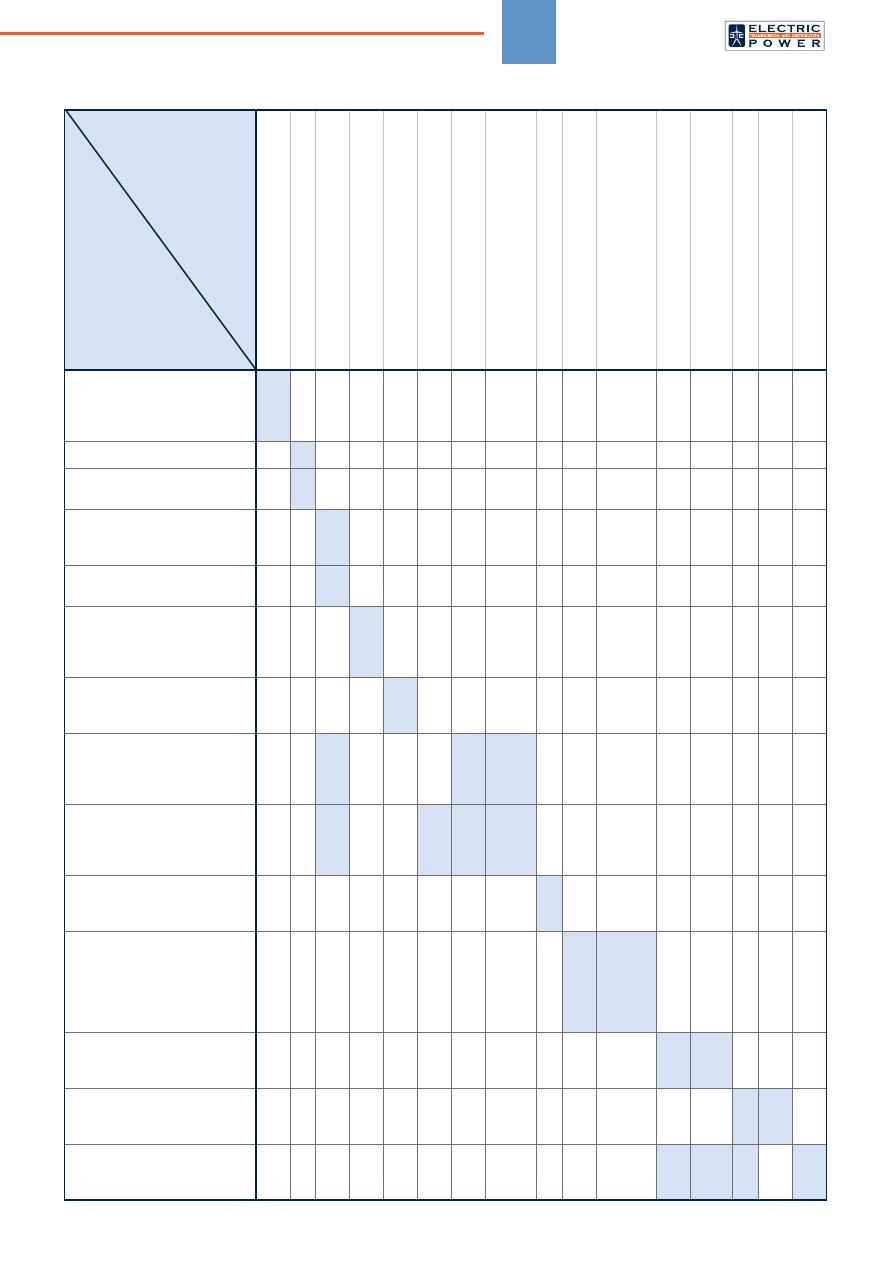
27
Table 2. Matrix of technical solutions
Operating
equipment
with manual
control and analog
data transmission
Operational information management
system, SCADA
(CIM)
Digital meters
Digital data acquisition and transmission
devices
Microprocessor-based relay protection and
automation with IEC protocol support
Microprocessor-based telemechanics with
IEC protocol support
Digital communication equipment (commu- nication through high-frequency channel)
Digital communication equipment (cellular
and radio communication)
Digital communication equipment (commu- nication through
fi
ber optic communication
line)
Sectionalizing points / reclosers
Measuring transformers with SF6 gas
insulation and cast insulation
Measuring transformers with SF6 gas
insulation and cast insulation and analog
converters or digital measuring trans- formers
High-voltage vacuum circuit breakers or
SF6 circuit breakers
High-voltage vacuum circuit breakers or
SF6 circuit breakers with digital transducers
Remote control drive
Disconnectors and grounding blades with
motor drive
6-35 kV load break switches with motor
drive
Substations not provided
with software and hardware
for equipment display and
control
Induction meters
Electronic meters without
remote data collection
Data acquisition and trans-
mission devices without sup-
porting IEC protocol
Lack of data acquisition and
transmission devices
Relay protection and automa-
tion based on electrome-
chanical and microelectronic
elements
Telemechanics based on
electromechanical and micro-
electronic elements
Analog communication
equipment (communication
through cable communication
line)
Analog communication
equipment (communica-
tion through high-frequency
channel)
Necessity of 6-35 kV electri-
cal network sectioning (power
transmission lines)
Measuring transformers not
satisfying metrological re-
quirements (accuracy class,
transformation ratio, rated
power, number of secondary
windings, etc.)
High-voltage circuit breakers
not providing control and
monitoring functions
Disconnectors and grounding
blades not providing control
and monitoring functions
6-35 kV load break switches
not providing monitoring
function
Installed equipment
with remote control
and digital data
transmission
47th CIGRE Session
Special issue, August 2018
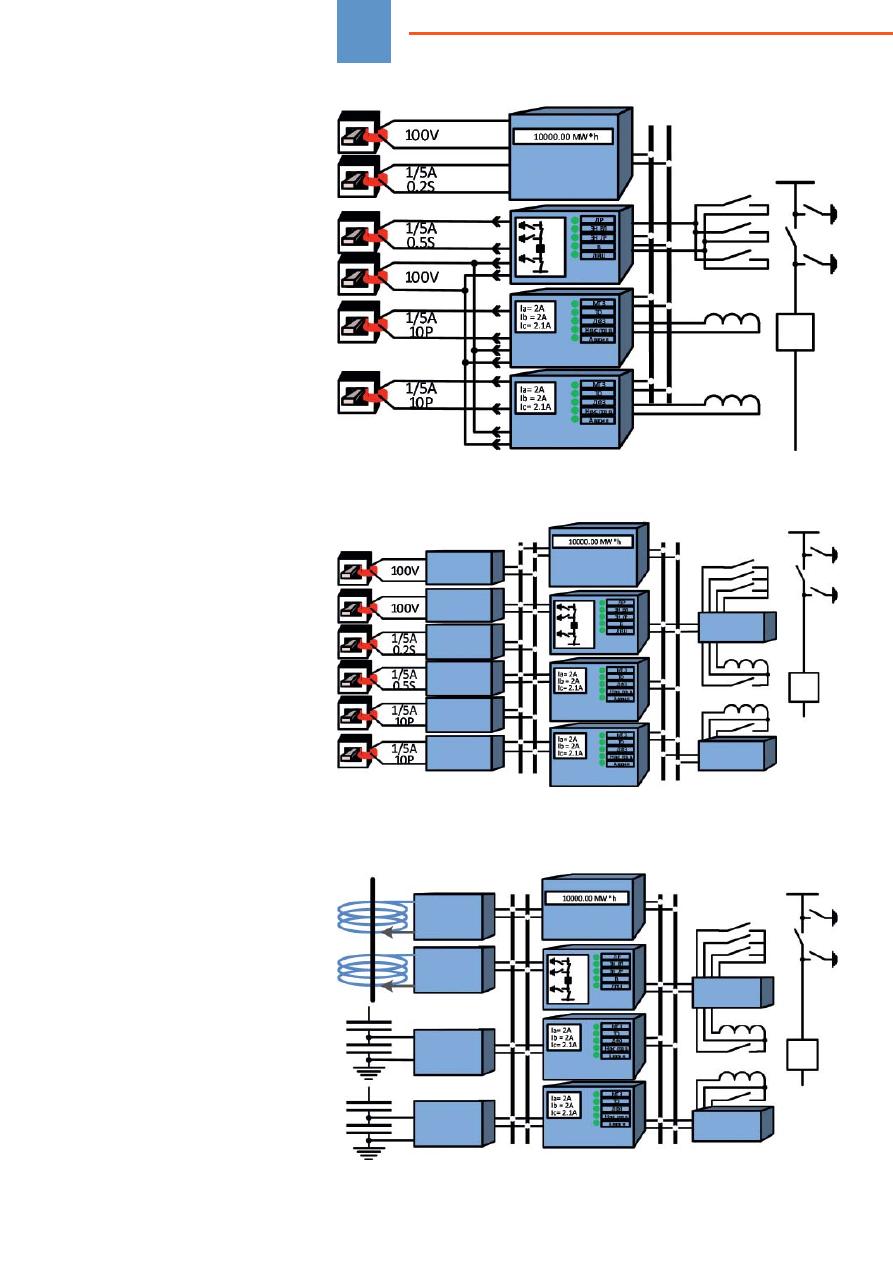
28
control signals to switching
devices without digitizing;
– use of IEC 61860-8.1
GOOSE station bus for com-
munication with Automa
tic
Process Control System
(APCS);
2) the second type of architecture
(Figure 4) is characterized by
the following features:
– use of electromagnetic mea-
suring current transformers;
– conversion of analog data
into digital format according
to IEC 61850-9.2 SV pro-
tocol;
– transmission of analog sig-
nals to the substation auto-
mation devices via process
bus in the format of IEC
61850-9.2 SV protocol;
– conversion of discrete
signals into digital format
according to IEC 61860-8.1
GOOSE protocol;
– transfer of discrete signals
to the substation automation
devices via station bus in
the format of IEC 61850-8.1
GOOSE, MMS protocol;
3) the third type of architecture
(Fi gure 5) is characterized by
the following features:
– use of digital measuring
transformers generating digi-
tal data in accordance with
IEC 61850-9.2 SV protocol;
– transmission of analog sig-
nals to the substation auto-
mation devices via process
bus in the format of IEC
61850-9.2 SV protocol;
– conversion of discrete signals
into digital format according
to IEC 61860-8.1 GOOSE
protocol;
– transfer of discrete signals
to the substation automation
devices via station bus in
the format of IEC 61850-8.1
GOOSE, MMS protocol;
The choice of digital substa-
tion architecture depends on sub-
station layout complexity, number
and type of equipment. It is obvious
that small single-transformer sub-
stations shouldn’t be digitized ac-
cording to architecture no. 3. In this
case architectures no. 1 or no. 2
are convenient options. The maxi-
mum effect from architecture no. 3
Figure 5. Architecture of digital substation type no. 3
Figure 3. Architecture of digital substation type no. 1
IEC 61860-8.1
GOOSE station bus
Automated power
consumption
measurement
system
Teleme-
chanics
Circuit breaker
opening/closing
solenoids
Circuit breaker
opening solenoid 2
Relay protection
and automation 1
Relay protection
and automation 2
Figure 4. Architecture of digital substation type no. 2 (SHS – software/hardware
system; VT – voltage transformer,
С
T –
с
urrent transformer)
IEC 61850-8.1
GOOSE, MMS
station bus
IEC 61850-9.2
SV process
bus
Automated power
consumption mea-
su rement system
Digital merging
unit 1
Digital merging
unit 2
SHS
(VT for
capa citor unit)
SHS
(CT for
capa citor unit)
SHS
(VT for
relay protection
and automation)
SHS
(CT for
telemechanics)
SHS 1
(CT for
relay protection
and automation)
SHS 2
(CT for
relay protection
and automation)
Teleme-
chanics
Circuit breaker open-
ing/closing solenoids
Circuit breaker
opening solenoid 2
Relay protection
and automation 1
Relay protection
and automation 2
IEC 61850-8.1
GOOSE, MMS
station bus
IEC 61850-9.2
SV process
bus
Automated power
consumption mea-
su rement system
Digital
merging unit 1
Digital
merging unit 2
Digital
current
transformer 1
Digital
voltage
transformer 1
Digital
current
transformer 2
Digital
voltage
transformer 2
Teleme-
chanics
Circuit breaker open-
ing/closing solenoids
Circuit breaker
opening solenoid 2
Relay protection
and automation 1
Relay protection
and automation 2
POWER GRIDS
DIGITALIZATION

29
Table 3. ROSSETI Group digital substations projects under realization
Number
of sub-
stations
Digital
technology
Characteristics
Subsidiaries and af
fi
liates
Fully digital
substations
4 sub-
stations
(under way)
Digital
substations
Support
IEC 61850-8.1/9.2,
IEC 60870-5-104
PJSC "MOESK"
(110 kV "Medvedevskaya" sub station);
PJSC "IDGC of North-West"
(110 kV "Yuzhnaya"
substation);
PJSC "Kubanenergo"
(110 kV "Tuapse-
gorod" substation);
PJSC "IDGC of Centre"
(110 kV
"Stroitel" substation)
Pilot
implementation
of certain
digital
substation
technologies
4 sub-
stations
Digital relay
protection,
Digital automatic
process control
system
Support
IEC 61850-8.1/9.2,
IEC 60870-5-104
JSC "Tyumenenergo"
(110 kV "Olimpiyskaya"
substation);
PJSC "IDGC of Siberia"
(110 kV
substation named after M. Smorgunov);
PJSC "MOESK"
(35 kV "Babayki" substation);
PJSC FGC UES
(110 kV substation no. 301)
1 sub station
1 substation
(under way)
Digital
measuring
transformers
Support
IEC 61850-9.2
PJSC FGC UES
(110 kV substation no. 301);
PJSC FGC UES
(500 kV "Tobol" substation)
Industrial
application of
certain digital
substation
technologies
35 sub-
stations
Digital automatic
process control
system
Support
IEC 61850-8.1
PJSC FGC UES; JSC "Yantarenergo"; JSC "Tyumen-
energo"; PJSC "IDGC of Centre"; PJSC "MOESK";
PJSC "IDGC of the South"; PJSC "IDGC of Volga"
More than
1000 sub-
stations
Data collection
and transmission
system
Support
IEC 60870-5-104
All subsidiaries and af
fi
liates
Figure 6. 110 kV substation named after M. Smorgunov with digital control system
application can be achieved at sub-
stations with several transformers,
complicated connection layout and
a large number of connections.
ROSSETI Group implements
digitalization pilot projects with vari-
ous types of architectures and sub-
stations in order to determine the
criteria for choosing digital substa-
tions architecture.
It should be noted that ROSSETI
Group has already implemented
substations using local digital so-
lutions. Such substations provide
power supply of Moscow Energy
Ring and Winter Olympics facili-
ties in Sochi. In addition, a number
of digital substations projects with
various architectures (no. 2 and
no. 3) have been implemented for
testing design decisions and gain-
ing operation experience. 110 kV
substation named after M. Smor-
gunov with digital control system
according to architecture no. 2 was
put into operation in December
2017 in Krasnoyarsk.
500 kV digital switching "Tobol"
substation using data transmission
in accordance with architecture no.
3 was put into operation in the Tyu-
men Region in 2018. The similar
facilities were also built in the Mos-
cow region.
Eventually, ROSSETI Group in-
tends to carry out power grid digital
transformation by 2030. It allows
ROSSETI Group to get manage-
able, intelligent electric grid with
a high level of power supply reliabil-
ity and a number of positive internal
effects.
The creation of digital networks,
even according to the most cau-
tious forecasts, will result in reduc-
tion power losses, capital expendi-
tures and operating expenses by
30%. SAIDI and SAIFI reliability
indicators should be improved by
50%.
REFERENCES
1. Livinsky P.A., Gvozdev D.B. Inno-
vative power system of Russia in
2050. Energeticheskaya politika
[Energy Policy], 2017, no. 6. pp. 16-
19. (in Russian)
47th CIGRE Session
Special issue, August 2018
Оригинал статьи: Development of Cooperation in Power Industry
Russian companies actively work to set up interstate integration with power engineers and electrical engineering companies of the world. The most important targets of the work are European countries and rapidly developing regions of Asia.





